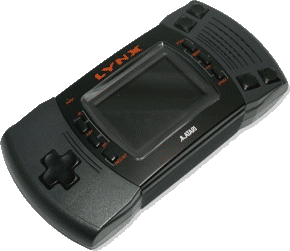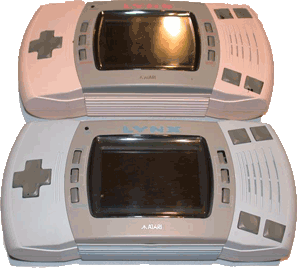Presentation
The Atari Lynx is a 16-bit handheld game console that was released by Atari Corporation in September 1989. The Lynx holds the distinction of being the world's first handheld electronic game with a color LCD. The system is also notable for its forward-looking features, advanced graphics, and ambidextrous layout. As part of the fourth generation of gaming, the Lynx competed with Nintendo's Game Boy (released just a month earlier), the Sega Game Gear and NEC's TurboExpress, both released the following year.
Today, as with many older consoles, there is still a small group of devoted fans, creating and selling games for the system.


Historique
The Lynx was the second handheld game with the Atari name to actually be produced. The first was Atari Inc.'s handheld electronic game Touch Me. Atari Inc. had previously worked on several other handheld projects including the Breakout, Space Invaders, and the Atari Cosmos portable/tabletop console. However, those projects were shut down during development, some just short of their intended commercial release.
The Lynx system was originally developed by Epyx as the Handy Game. Planning and design of the console began in 1986 and was completed in 1987.[4] Epyx first showed the Handy system at the Winter Consumer Electronics Show (CES) in January 1989. Facing financial difficulties, Epyx sought out partners. Atari Corp. and Epyx eventually agreed that Atari Corp. would handle production and marketing, while Epyx would handle software development.
Atari Corp. changed the internal speaker and removed the thumb-stick on the control pad before releasing it as the Lynx, initially retailing in the US at US$179.95. Atari Corp. then showed the Lynx to the press at the Summer 1989 CES as the "Portable Color Entertainment System", which was changed to Lynx when actual consoles were distributed to resellers.
The Lynx started off successful. With Atari reported that they had sold 90% of the 50,000 units it shipped in its launch month in the U.S..[5] US sales in 1990 were approximately 500,000 units according to the Associated Press[6] In late 1991, it was reported that Atari sales estimates were about 800,000, which Atari claimed was within their expected projections.[7] Lifetime sales by 1995 amounted to less than 7 million units when combined with the Game Gear.[8] In comparison, the Game Boy sold 16 million units by 1995.[8] Atari did not release sales numbers from other regions. The German history text book "The encyclopedia of consoles, handhelds & home computers 1972 - 2005", quotes Atari revealing over 2 million units sold in 1994 during an interview with the German Newspaper Bild-Zeitung, "Atari had talked to past Newspaper editor Randolf Heinz, of Bild-Zeitung fame, about rising ST sales in Germany and that their recent success was due to the increased market penetration of the brand due to the Lynx game device marketed towards children, and the low prices of it's 8-bit computers, which reached 200,000 in Germany. They claimed Lynx machine sales were 2 million worldwide as of 1994 last year, with 150,000 in Germany alone."
As with the actual console units, the game cartridges themselves evolved over the first year of the console's release. The first generation of cartridges were flat, and were designed to be stackable for ease of storage. However, this design proved to be very difficult to remove from the console and was replaced by a second design. This style, called "tabbed" or "ridged", used the same basic design as the original cartridges with the addition of two small tabs on the cartridge's underside to aid in removal. The original flat style cartridges could be stacked on top of the newer cartridges, but the newer cartridges could not be easily stacked on each other, nor were they stored easily. Thus a third style, the "curved lip" style was produced, and all official and third-party cartridges during the console's lifespan were released (or re-released) using this style.


During 1990, the Lynx had moderate sales. In 1991, Atari Corp. introduced the Lynx II with a new marketing campaign, new packaging, slightly improved hardware, better battery life and a new sleek look. The new system (referred to within Atari Corp. as the "Lynx II") featured rubber hand grips and a clearer backlit color screen with a power save option (which turned off the LCD panel's backlighting). It also replaced the monaural headphone jack of the original Lynx with one wired for stereo. The new packaging made the Lynx available without any accessories, dropping the price to $99. Although sales improved, Nintendo still dominated the handheld market.
In 1994, Atari Corp. shifted its focus away from the Lynx. As Nintendo's Super Nintendo and Sega's Sega Genesis filled retailers' shelves, Atari Corp. refocused its efforts on its Jaguar console. A handful of games were released during this time, including Battlezone 2000. In 1996, Atari shut down its internal game development.
Telegames released a number of games in the second half of the 1990s, including a port of Raiden and a platformer called Fat Bobby in 1997, as well as an action sports game called Hyperdrome in 1999. At the end of the 1990s, Hasbro, the owners of the Atari properties at the time, released the rights to develop for the system to the public domain. Since then a number of independent developers released games into the new decade, like Championship Rally, CyberVirus, and Alpine Games.[11] Some of the late 90s/early 2000s games were under development by other companies at one time, but rights to the game programs and all of the existing code was bought and finished by other developers.[12]
In 2008 Atari was honored at the 59th Annual Technology & Engineering Emmy Awards for pioneering the development of handheld games with its Lynx game unit.
On October 24, 2009, North American company Super Fighter Team released Zaku, a horizontal shooter for the Lynx developed by PenguiNet. It was the first new game for the system since the 1990s whose game card has an authentic "curved lip" plastic shell instead of a custom bare circuit board.
Technical Specification :
Bus : 16 bits
Processor : 65C02 @ 3,6 MHz
Ram : 64 KB
Rom : 128 KB Cartridge to 1 MB
Color : 16 Colors on screen from 4096
Resolution : 160x102







.webp)
.webp)
.webp)